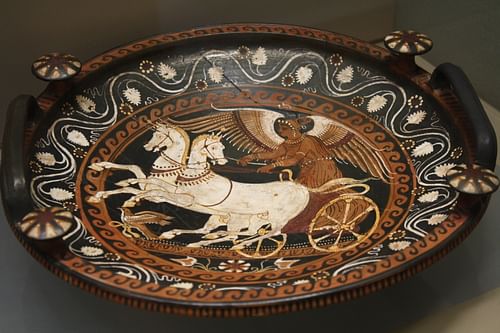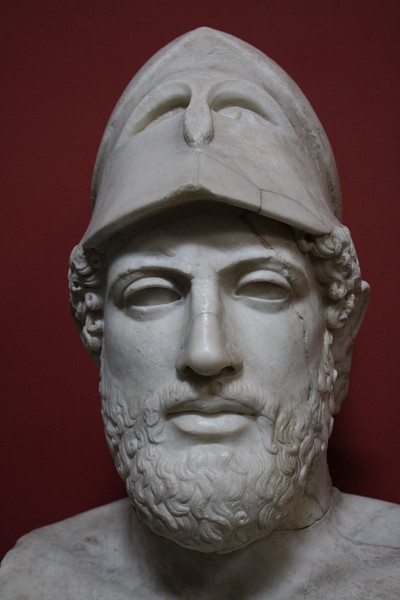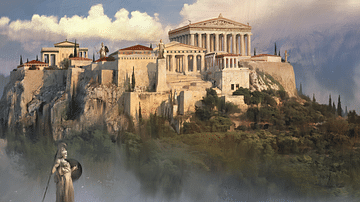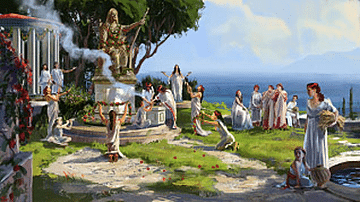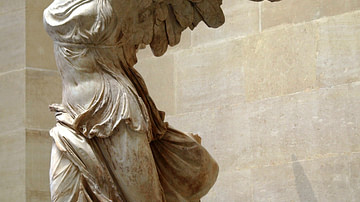The Temple of Athena Nike, on the southwest bastion of the Acropolis, is smaller than the other buildings behind it but no less impressive. It was completed in 420 BCE during the restoration of Athens after the Persian invasion of 480 BCE and was designed to greet those visiting Athena’s complex.
Visitors to the Acropolis entered through the Propylaia, the main gate, which was flanked by a monumental pedestal to one’s left and the Temple of Athena Nike to one’s right. Athena was patron deity of Athens and Nike was the goddess of victory often associated so closely with her that the two became synchronized as Athena Nike ("Athena of Victory"). The small Ionic temple honored Athena in her role as protector and defender of Athens and provided 5th-century BCE visitors with a kind of preview of the other temples dedicated to the goddess they would see after passing through the gate.
The Greek temple stood for almost 2,000 years until it was dismantled by the occupying Turks of the Ottoman Empire in 1687 who used the materials as a defensive wall in one of their engagements with the Venetians. After Greece won its independence in 1821, restoration efforts at the Acropolis included the Temple of Athena Nike which was rebuilt in 1834.
It was dismantled again in the 1930s, this time by archaeologists who noted flaws in the earlier reconstruction, and was again restored in 2010. The present temple construction is considered to be the closest to the original although some stones, reliefs, and sections of the parapet that surrounded it on three sides have been lost or are now in the Acropolis Museum and the British Museum.
Athena & Nike
As noted, the temple was dedicated to Athena as the victorious protector and defender of Athens. Athena Nike was only one of her many epithets, which included Athena Ergane ("Athena the Industrious"), Athena Promachos ("Athena who Fights from the Front") and Athena Parthenos ("Athena the Virgin"), this last, of course, giving the Parthenon its name. It is possible she was developed from earlier Mesopotamian, Phoenician, or Egyptian deities, but this claim is challenged. Scholar Robert E. Bell, for example, claims she is a complete reflection of Greek culture from her earliest mention:
Athena was purely a Greek goddess, unless the story of her birth in Libya suggests her worship spread from the African continent. We do not find any foreign goddesses from whom she was borrowed, however, as in the case of Artemis and Aphrodite. Evidence of her strong Greek identity was demonstrated in her association with the Greek warlike spirit and patriotism. Her benefits to early inhabitants were endless and she was champion of many of their most glorious heroes. (84)
Athena was the daughter of Zeus, the king of the gods, and, according to Greek mythology, was born fully grown from his forehead. She was one of the most popular deities in ancient Greece as the goddess of warfare, wisdom, crafts, and cooking but she was also associated with agriculture and certain musical instruments. Primarily, at Athens, she was associated with the strength of the state and her worship encouraged individual identification with the state’s interests.
Nike (sometimes given as Nice and often referred to as Winged Victory) was a primeval power of victory born of the god of warfare, Pallas, and the goddess of hatred, Styx, who also presided over the River Styx in the underworld. She was an unstoppable force who, along with her brothers and sisters, helped Zeus defeat the Titans and establish the order of the Twelve Olympian Gods of Greece. Zeus thanked her by allowing her and the others to live among the gods on Mount Olympus.
Nike, therefore, came to be associated with Zeus as the most powerful of the gods, with Athena through her connection to Greek warfare, and to Aphrodite, goddess of love, who promised her followers the same kind of victory in their amorous pursuits as other deities did in war. She is usually depicted as a winged woman in robes (the Nike of Samothrace is the most famous representation) and was featured in a number of statues of the gods, notably standing in the right hand of Athena’s famous statue in the Parthenon.
Athena Wins Athens
It is unclear when Athena became the patron goddess of the city as the story is mythological. There are a number of variations on the tale, but all claim she won a contest with Poseidon over who would preside over the city all the gods considered the most beautiful. Poseidon struck a rock on the Acropolis and provided the city with fresh water while Athena planted a seed which grew quickly into an olive tree. The Athenians recognized the value of the tree and so chose Athena.
In some versions, however, the details significantly vary. Bell gives one version in which the mythical King of Athens, Cecrops, plays a pivotal role:
Cecrops, an autochthon [sprung from the earth], said by some to be the first king of Attica, gained Athena’s favor when he witnessed for her in her dispute with Poseidon over the possession of Athens. Poseidon had opened a well on the Acropolis, and Athena had planted an olive tree. Her gift was judged to be more important, so she became the protectress of Athens. (85)
In another version, Poseidon’s gift is rejected because he brings forth saltwater but, as this would have been a useless gift no god would give, it is thought some early scribe made a mistake in copying. The best-known version of the story is thought to have been created to explain why the women of Athens had no political voice or active role in the life of the city. In this version, after Athena and Poseidon have presented their gifts, the people voted which they favored. The men all voted for Poseidon and the women for Athena, and since there was one more woman than the men, Athena won. To appease Poseidon’s wrath, women were no longer allowed to vote on anything and were required to remain at home under male supervision.
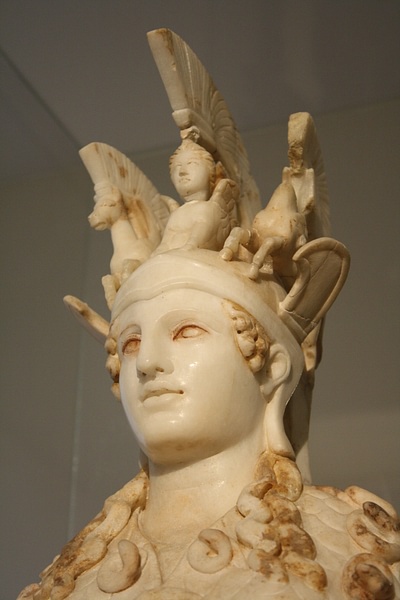
Early Acropolis & Worship
This version of the myth is reported later by the Roman writer Varro (l. 116-27 BCE), and it is unclear when it was first written. According to scholar Robin Waterfield, the basic story of the contest between Athena and Poseidon most likely signifies an early loss of status for the god to the goddess when villages in Attica banded together under her divine protection. Waterfield notes, "if the chief deity of one of these original villages was Poseidon, the myth reflects his losing out to Athena" (36). This may have happened as far back as the Mycenaean Civilization (c. 1700-1100 BCE) who first developed the region, though it could have been later.
The Acropolis was inhabited as early as the Neolithic Period, as well as the surrounding area, but developed under the Mycenaeans. The Mycenaeans constructed a fortress and palace on the Acropolis with huge walls (known as Cyclopean Walls) of stone carefully fit together, a technique which would be used by later builders at the site for post-Mycenaean temples.
The Mycenean Civilization began to decline c. 1100 BCE during the period known as the Bronze Age Collapse, but the culture would be immortalized later in the works of Hesiod (8th century BCE) and, especially, Homer (8th century BCE) who depicted the Mycenaeans as great heroes exemplifying Greek virtues. The Athenians seized on the Mycenaean connection to their city and considered themselves direct descendants, fashioning their early building projects on Mycenaean models.
There was an earlier temple dedicated to a female deity at the site of the later Temple of Athena Nike in Mycenaean times as evidenced by Bronze Age artifacts found buried beneath the present site. This earliest temple seems to have had a central pit into which adherents would pour offerings, perhaps of wine or oil, and then throw in the container. Figurines, most likely of gods and spirits, have also been excavated at the site.
The first temple clearly dedicated to Athena Nike was built in the 6th century BCE on the ruins of this earlier structure using the Mycenaean technique of the Cyclopean Walls of fitted stone. What this building looked like is unknown as it was later completely destroyed, but it seems to have been a small temple located on the southwest bastion of the Acropolis that faced east toward an altar where sacrifices to the goddess were made.
Persian Invasion & Pericles’ Restoration
In 490 BCE, the Persians invaded Greece in retaliation for Athenian support of the revolt of the Ionian Greeks of Asia Minor against the Achaemenid Empire (c. 550-330 BCE) but were defeated at the Battle of Marathon. Darius I (the Great, r. 522-486 BCE), emperor of the Persians, planned a second invasion, but the execution of the attack would fall to his son, Xerxes I (r. 486-465 BCE) who launched his campaign in 480 BCE.
After defeating King Leonidas (d. 480 BCE) and his 300 Spartans at Thermopylae, Xerxes I marched on Athens and burned it. The temples on the Acropolis, the monuments, fountains, and buildings of the agora below, and the surrounding area were all destroyed. After the Greeks won their decisive victory at Salamis (480 BCE), and again at Plataea and Mycale in 479 BCE, the Persians retreated and Athens, which had contributed significantly to their defeat, became the superpower of Greece.
The statesman Pericles (l. 495-429 BCE) convinced the men of Athens to not only restore but beautify the city. Using funds raised privately, donations from admirers, and public funds of the Delian League which were supposed to fund defense against another Persian attack, Pericles created one of the most impressive cities of the ancient world, and among the many buildings and monuments he raised was the Temple of Athena Nike to celebrate and immortalize the Greek victory over the Persians.
The Temple of Athena Nike
The official decree for construction was issued in 449 BCE, but lack of funding prevented any work until c. 427 BCE, two years after Pericles died in the Plague of Athens of 429 BCE. The temple was designed by Kallicrates (also given as Callicrates, l. c. 470-420 BCE), one of the architects of the Parthenon. It was completed in 420 BCE at which time it would have been blessed and consecrated by the women of Athena’s cult, presided over by the high priestess, the only position of power a woman could hold in Athens.
The temple was 23 feet (7 m) tall, 18 feet (5 m) wide, and 27 feet (8m) long with colonnades on the front and back supported by four Ionic columns each. It was made of Pentelic marble which is the famous golden-white stone from Mount Pentelicus northeast of central Athens. Stones were quarried at Pentelicus and brought miles to the site where they then had to be carried uphill to the edge of the Acropolis and set in position on the base of the temple that had been destroyed.
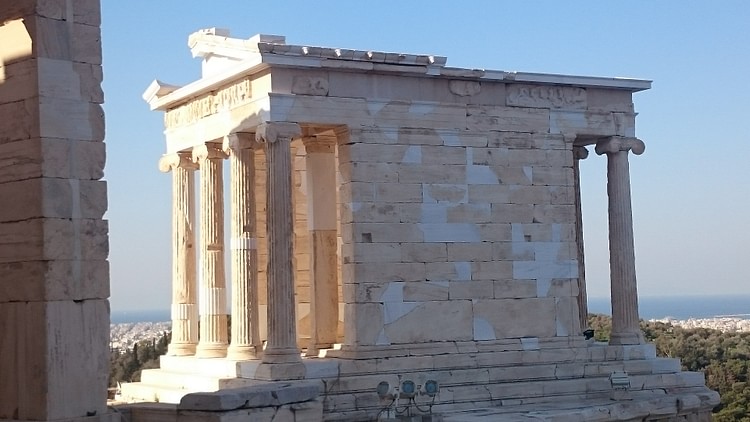
This site was on a steep bastion of an outcropping of the rock of the Acropolis with a sheer drop on three sides. The side nearest to the Propylaia overlooked the stairway, a short but survivable fall if any visitor lost their balance, but the other two sides offered far more serious injuries if anyone should slip. To prevent such accidents, a marble parapet 3 feet (1 m) tall was built c. 410 BCE surrounding the three sides with elaborately carved reliefs depicting Nike and Athena in a variety of activities. Scholar G. Papathanassopoulos notes:
[The parapet was] decorated with winged Victories in high relief and graceful figures of Athena on three sides of the temple. The Victories presented in many variations, usually leading animals to sacrifice, offering gifts to the goddess, decorating a trophy. The parapet [was] the work of Callimachus who was one of the most famous sculptors of the end of the 5th century BCE. It seems that, for reasons of security, the parapet was surmounted by an iron grille. (30)
Scholar and art historian John Griffiths Pedley notes, "the hands of six different sculptors have been detected in this work" which was supervised and conceived of by Callimachus (268). Callimachus made use of a technique known as wet drapery by which a sculptor allows a full appreciation of the body of a subject while keeping them fully clothed. The most famous example of this is the relief of Athena (or Nike) adjusting her sandal, presently housed in the Acropolis Museum but originally part of the parapet of the temple. In this relief, a young, robed woman is seen pausing, mid-stride to fix her sandal. The robe seems sheer and clings to her body (hence the term “wet drapery”) but provides enough covering to convey the modesty of the virgin goddess. Pedley comments:
The Nike adjusting her sandal demonstrates clinging drapery at its most transparent. The garment slips from the right shoulder, but the left is equally visible. This new, precarious posture allowed drapery folds swinging across the figure to reveal the legs, while the clothing pressed against the torso makes the breasts visible, though they are covered. (268)
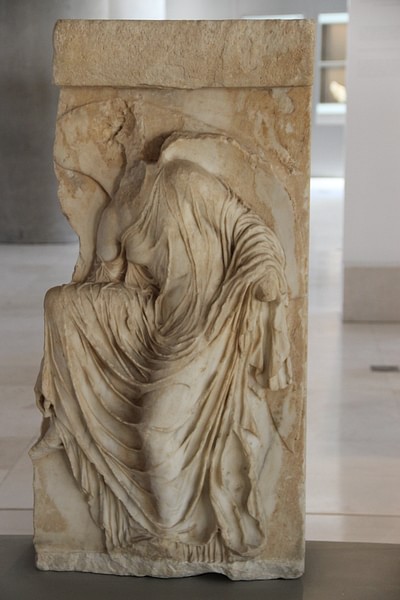
The architrave of the temple was decorated with friezes of divinities (the north frieze and east frieze) and the Greek victory over the Persians in the south frieze and then the Athenians fighting other Greeks (no doubt an allusion to the First Peloponnesian War) on the west frieze. On the north side was the doorway into the inner chamber where, according to the historian and geographer Pausanias (l. 110-180 CE), stood a statue of Athena Nike, made of wood, and without wings. Since the statue had no wings, and all Nike statues had wings, Pausanias concluded the temple was dedicated to Apteros Nike (wingless victory) and started the rumor that the statue was purposefully created without wings so that victory could never leave Athens. The statue was actually of Athena, who was never depicted with wings, not Nike, and Pausanias, though he created a story still repeated by writers in the present day, was wrong.
Conclusion
The temple continued in use by the Athenian people through the Roman Period and survived, completely intact, the sack of Athens in 87-86 BCE by the general Sulla as well as later invasions of barbarian tribes and the rise of Christianity, which saw the destruction of many pagan temples and shrines or their conversion into churches. The Temple of Athena Nike, as well as the Parthenon, were thought suited to the veneration of the Virgin Mary and were put to that use.
In 1458, Greece was conquered by the Ottoman Empire, and Athens, as well as the country generally, entered a period of decline. The Turks turned the Parthenon into a mosque but left the small temple alone until 1687 when, under attack by the Venetians, they dismantled it completely to build a bastion beside the Propylaia for defense. The stones and pillars of the temple remained in this position, seemingly part of the Propylaia, until 1834, after Greece had won its independence, when architects working with archaeologists dismantled the bastion and reconstructed the temple.
In the 1930s, it was dismantled again because of structural problems and rebuilt in 1940, using the technique known as anastylosis (rebuilding an ancient structure using its original elements), but it was later noted that the blocks of the temple were not in their original places. This seems to have been determined by their fit and how well they sat with the stones around them. Between 2000-2010, the temple was again dismantled and rebuilt as it would have looked, obviously minus the loss of various significant aspects, in Classical Athens. Although it is the smallest temple on the Acropolis, and both literally and figuratively overshadowed by the Parthenon, it remains a welcoming little gem to visitors today just as it was in the past.

